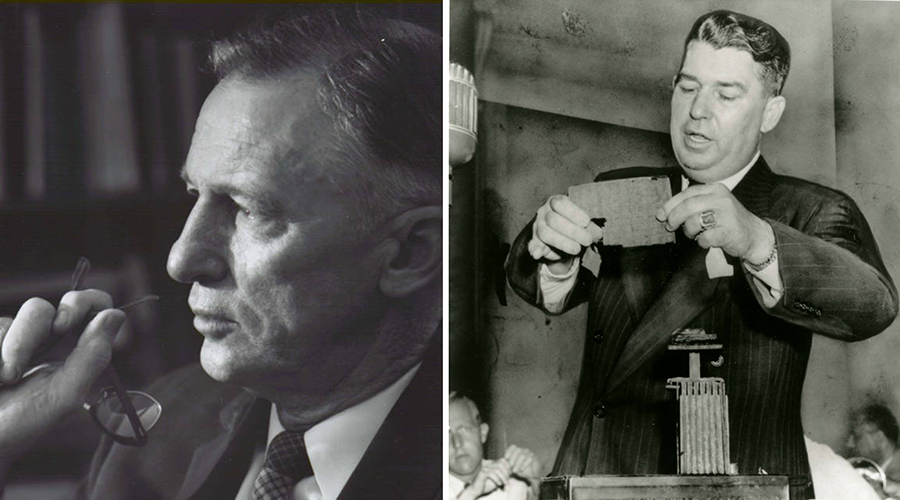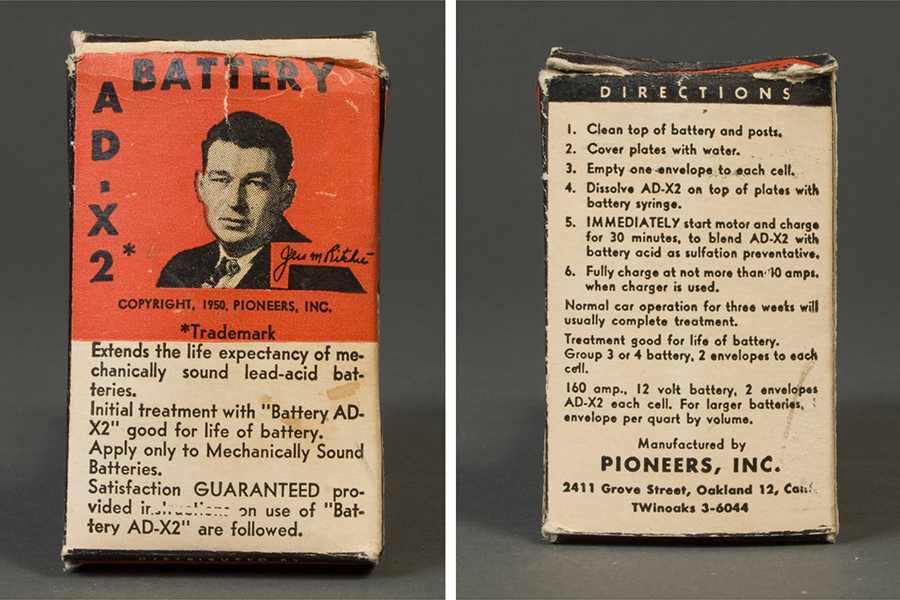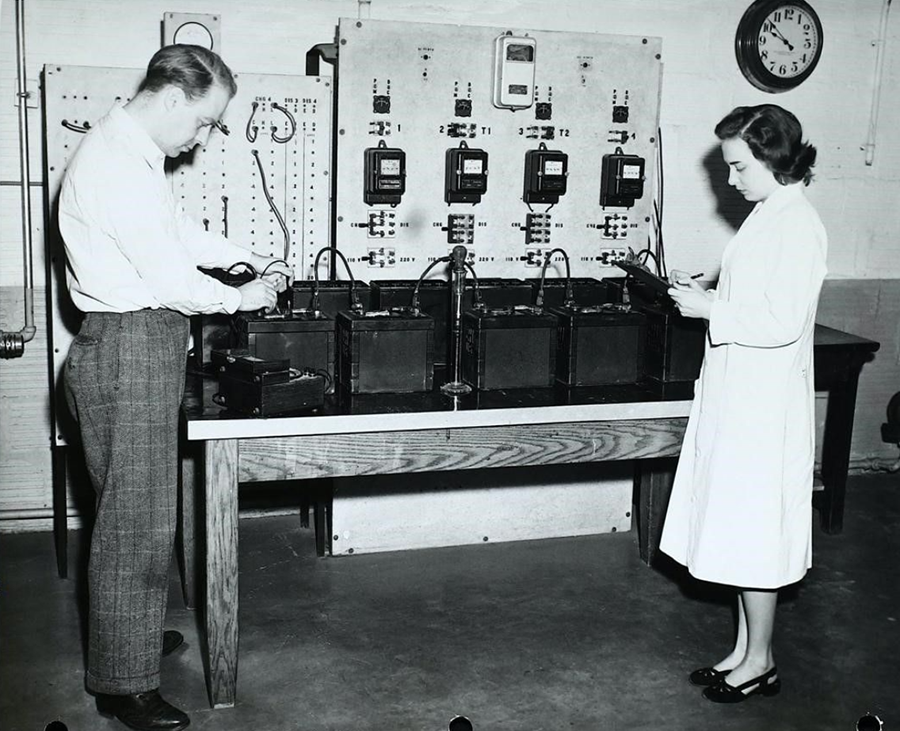May 1, 1953: In AD-X2 Controversy, Allen Astin and APS Defend Federal Science Against Political Interference
Astin upheld his agency’s rigorous consumer testing results — and was fired for it. Then the nation’s scientists found out.
By Kendra Redmond | April 12, 2024

Credit: NIST
Physicist Allen Astin, left, and businessman Jess Ritchie. In a protracted dispute, Astin became the unwitting face of government science.
At an APS meeting on May 1, 1953, Allen Astin, physicist and director of the National Bureau of Standards — today the National Institute of Standards and Technology — took the stage. Before an audience of some 500 fellow physicists, he delivered a powerful speech about the bureau’s core values.
“Tonight, I plan to speak as the Director of the National Bureau of Standards,” he said, “and attempt to explain why I and the other members of the organization believe in the Bureau and the importance of its operation to the national welfare and security.”
Astin didn't say it directly, but everyone knew the impetus for the lofty talk. Less than six weeks earlier, the U.S. Secretary of Commerce had fired Astin after he stood by the bureau’s scientific findings in the face of opposing political interests. Outraged, hundreds of bureau staff threatened to quit alongside him, and he was temporarily — and later permanently — reinstated.
The episode capped a yearslong tussle between the science agency and the bullheaded seller of a disproven product. It also forced the American public to grapple with a vital question: To which principles were U.S. government scientists beholden?
The saga had begun five years earlier, with a small, red packet of powder.
In 1947, a charismatic California businessman named Jess Ritchie began selling a car battery additive, dubbed “AD-X2.” With lead in short supply in the years after World War II, Ritchie claimed that his powder could double or triple a lead-acid car battery's life.

Credit: NIST
Jess Ritchie’s battery additive AD-X2.
But scientists at the National Bureau of Standards had already studied battery additives nearly 20 years earlier. “These materials do not charge storage batteries,” a 1931 notice from the bureau read, “nor do they materially improve the performance of the batteries.”
For Ritchie, the notice was a problem. So in April 1948, he asked the bureau to exempt AD-X2 from the notice. The bureau, having already studied the issue, declined. But Ritchie had customers in powerful positions. Later that year, the Better Business Bureau and a U.S. senator from California climbed into the ring, asking the bureau to test AD-X2.
Already testing another additive, bureau scientists added AD-X2 to the lineup. The results were the same: The powder, a mix of sodium and magnesium sulfates, had no measurable impact on battery performance, which the bureau reported in a new notice.
Ritchie responded in protest, organizing a letter-writing campaign among his supporters. By early 1952, multiple federal agencies and a congressional committee had all requested new tests on AD-X2, and 29 members of Congress had contacted the bureau about the additive.
The pressure fell squarely on Astin, a respected bureau scientist who had become acting director six months earlier. “He was quiet — very reserved,” says historian Nelson Kellogg, in the NIST documentary The AD-X2 Controversy, of Astin. “He saw himself primarily as a bench scientist, and then as an administrator of an army of bench scientists.”
Astin agreed to test AD-X2 one more time, this time using a procedure Ritchie said was sure to reveal its merits. Recognizing the political sensitivity of the situation, Astin personally supervised the test in May 1952.

Credit: NIST
National Bureau of Standards staff studying whether battery additives like AD-X2 impact a battery’s performance or life. The studies revealed again and again that additives made no difference.
When the results were in, even Ritchie could not distinguish between the batteries that had received AD-X2 and the controls, Astin later testified.
Ritchie raised complaints about the test and, with the support of a Senate committee on small business, pushed for yet another test, this time conducted by the Massachusetts Institute of Technology. The results were inconclusive, but Ritchie and his supporters promoted them as favorable. Ritchie claimed that he and AD-X2 were being persecuted by the bureau.
The controversy played out publicly, making headlines in The Washington Post and The New York Times. The press pitted Ritchie, the self-made man, against the Goliath government trying to squelch him. Public sympathy fell on Ritchie's side, but Astin remained quiet, trusting the bureau's integrity to speak for itself.
By April 1953, the U.S. Post Office had barred Ritchie’s materials from the mail over concerns of false advertising. But Ritchie had a strong new ally: Sinclair Weeks, recently appointed Secretary of Commerce. The newly elected Eisenhower administration had campaigned on supporting small businesses, and Weeks intended to fulfill that promise.
Ritchie, Weeks maintained, was the hapless victim of a biased bureau. He asked for Astin's resignation on March 24 and announced it on March 31, the opening day of a Senate committee hearing on the matter. Ritchie's company "has suffered severely at the hands of certain bureaucrats,” Weeks testified. “It is a wonder they are in existence at all after five years of struggle."
For many scientists, the news of Astin’s firing was deeply unsettling. Enrico Fermi, then president of APS, assembled a committee to investigate, and wrote to the APS Council. They decided to act. Their argument was essentially, "We have to act in this political matter in order to preserve our apolitical stance," says Joseph Martin, a Durham University science historian. APS began working on a statement.
The Federation of Atomic Scientists, the Washington Academy of Sciences, the International Electrochemical Society, and other organizations and individual scientists did the same, calling out the dangers of political overreach in government science. Nearly 400 bureau scientists said they would leave alongside Astin, a loss that would have hobbled the bureau’s work.
When the press caught wind of the firing and the backlash from the science community, the press narrative did an about-face. Astin, not Ritchie, became the victim — a civil servant of integrity refusing to bow to political pressure. "The tides change," says Martin.
In response to what Time magazine at the time called "the ensuing hullabaloo of scientific outrage and threatened resignations," Weeks temporarily reinstated Astin and agreed to let the National Academy of Sciences review the AD-X2 tests and have the final word.
On May 1, the APS Council approved a forceful statement. “It is the duty of a scientist to investigate scientific and technical problems by openly-stated objective methods without shading his conclusions under political or other pressures,” it read. “On this principle the progress of science depends. We have never doubted that the work of the Bureau of Standards has been conducted in this spirit.”
That same day, Astin delivered his speech to APS attendees, outlining the bureau’s values and thanking APS and others for the support. “We are sincerely grateful,” he said.
In the fall of 1953, a National Academy of Sciences report upheld the bureau’s work without reservation. Weeks fully reinstated Astin, who served as the director for another 16 years.
The experience was a political awakening for APS and the U.S. science community, Martin says. Scientists had engaged with politics before, but this was "perhaps the first incident where there's this mobilization directly against the prevailing political currents that is successful," he says. "The scientists are actually quite surprised that they're effective."
They didn't win it all. Weeks never officially recognized that the bureau was right about the additive, and the fraud order against Ritchie was lifted anyway. Still, the political win was crucial for the science community. A 1961 article in Science, citing the end to the AD-X2 affair, called it "a landmark in the preservation of scientific integrity against governmental whims and commercial exploitation.”
Kendra Redmond is a writer based in Minnesota.
For the National Institute of Standards and Technology, the AD-X2 story — and Allen Astin’s unwavering support of the agency’s scientific work — is a celebrated part of NIST’s history. To learn more, watch NIST’s short film, The AD-X2 Controversy.
©1995 - 2024, AMERICAN PHYSICAL SOCIETY
APS encourages the redistribution of the materials included in this newspaper provided that attribution to the source is noted and the materials are not truncated or changed.
Editor: Taryn MacKinney
May 2024 (Volume 33, Number 4)
Articles in this Issue

